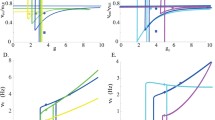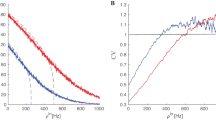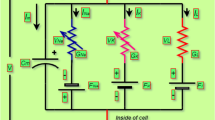Abstract
It was reported earlier that an inhibitory-feedback network inspired by neostriatal circuitry may exhibit a bistable character and spontaneous switching phenomenon within the neuronal activity. In the presence of noise and external excitation, a few local neurons switch “on” and generate streams of impulses while other neurons remain quiescent. In time, the existing “on” neurons spontaneously switch “off” and other neurons switch “on”. In this paper we examine the nature of the bistability and switching phenomenon using a simple model consisting of two mutually inhibitory neurons. For nonspiking neuron model, described by a system of nonlinear differential equations, we present a simple bifurcation analysis, which follows the birth and annihilation of two stable fixed points when model parameters are varied. We show that both nonspiking and spiking models may have two stable states, but only spiking neurons exhibit switching. The mechanism of switching for model spiking neurons, described by an equivalent RC circuit with a number of currents, is analyzed using computer simulations. It is shown that switching can be described by a two-state Markov chain with one parameter, which depends on the set of model physiological parameters, such as duration of afterhyperpolarization (AHP), maximum and the time duration of inhibitory post-synaptic potentials (IPSP's) and amplitude of the neuron noise input. “On” and “off” states of the model can be rapidly changed by localized excitatory input and the network then sustains the pattern of “on” and “off” states. That is, such a network can be used as a programmable memory device. Our hypothesis is that biological neural networks exhibit switches in their evolution to low energy states and switches are essential for the load and readout of the temporary and long term memory.
Similar content being viewed by others
References
Alexander GE, Crutcher MD (1990) Preparation for movement: neural representations of intended direction in three motor areas of the monkey. J. Neurophysiol 64:133–150
Bässler U, Koch UT (1989) Modelling of the active reaction of stick insects by a network of neuromimes. Biol Cybern 62:141–150
Borisyuk RM, Kirillov AB (1992) Bifurcation analysis of a neural network model. Biol Cybern 66:319–325
Buhmann J, Schulten K (1986) Associative recognition and storage in a model network of physiological neurons. Biol Cybern 54:319–335
Buhmann J, Schulten K (1987) Influence of noise on the function of a “physiological” neural network. Biol Cybern 56:313–327
Funahashi S, Bruce CJ, Goldman-Rakic PS (1989) Mnemonic coding of visual space in the monkey's dorsolateral prefrontal cortex. J Neurophysiol 61:331–349
Fuster JM (1990) Inferotemporal units in selective visual attention and short-term memory. J Neurophysiol 64:681–697
Grossberg S (1973) Contour enhancement, short term memory and constancies in reverberating neural networks. Stud Appl Math 52:213–257
Grossberg S (1988) Nonlinear neural networks: Principles, mechanisms and architectures. Neural Networks 1:17–61
Hanson FB, Tuckwell HC (1983) Diffusion approximations for neuronal activity including synaptic reversal potentials. J Theor Neurobiol 2:127–153
Harmon LD (1964) Neuromimes: action of reciprocally inhibitory pair. Science 146:1323–1325
Hebb DO (1949) The organization of behavior: a neuro-physiological theory. Wiley, New York
John ER (1972) Switchboard versus statistical theories of learning and memory. Science 177:850–864
Khibnik AI, Kuznetsov YuA, Levitin VV, Nikolaev EV (1992) Continuation techniques and interactive software for bifurcation analysis of ODEs and iterated maps. Physica D (to appear)
Kirillov AB, Myre CD, Woodward DJ (1991a) Working memory in 3D inhibitory-feedback model inspired by neostriatum. Int Joint Conf Neural Networks 91, Seattle WA 2:998
Kirillov AB, Myre CD, Woodward DJ (1991b) Bistable neurons and memory patterns in the inhibitory-feedback model inspired by neostriatum. Soc Neurosci Abstr 17, 51.6
Koch UT, Bässler U, Brunner M (1989) Non-spiking neurons suppress fluctuations in small networks. Biol Cybern 62:75–81
Little WA (1974) The existence of persistent states in the brain. Math Biosci 19:101–120
Little WA, Shaw GL (1975) A statistical theory of short and long term memory. Behav Biol 14:115–133
Matsuoka K (1985) Sustained oscillations generated by mutually inhibiting neurons with adaptation. Biol Cybern 52:367–376
Matsuoka K (1987) Mechanisms of frequency and pattern control in the neural rhythm generators. Biol Cybern 56:345–353
Morishita I, Yajima A (1972) Analysis and simulation of networks of mutually inhibiting neurons. Kybernetik 11:154–165
Myre CD, Sawyer SF, Woodward DJ (1989) Simulation of 1000-neuron inhibitory-feedback network reveals memory properties: computer modeling inspired by neostriatum. Soc Neurosci Abstr 15, 416.18
Myre CD, Woodward DJ (1990) Memory properties in the 1000-neuron inhibitory-feedback model for simulation of neostriatal circuits. Soc Neurosci Abstr 16, 446.18
Rashevsky N (1938) Mathematical biophysics. University of Chicago Press, Chicago
Reiss RF (1962) A theory and simulation of rhythmic behavior due to reciprocal inhibition in small nerve nets. Proc AFIPS Spring Joint Computer Conf 21:171–194
Suzuki R, Katsuno I, Matano K (1971) Dynamics of “neuron ring”. Kybernetik 8:39–45
Tuckwell HC (1979) Synaptic transmission in a model for stochastic neural activity. J Theor Biol 77:65–81
Wickens JR, Alexander ME, Miller R (1991) Two dynamic models of striatal function under dopaminergic-cholinergic control: simulation and analysis of a model. Synapse 8:1–12
Wilson DW, Waldron I (1968) Models for the generation of motor output patterns in flying locusts. Proc IEEE 56:1058–1064
Author information
Authors and Affiliations
Rights and permissions
About this article
Cite this article
Myre, C.D., Woodward, D.J. Bistability, switches and working memory in a two-neuron inhibitory-feedback model. Biol. Cybern. 68, 441–449 (1993). https://doi.org/10.1007/BF00198776
Received:
Accepted:
Issue Date:
DOI: https://doi.org/10.1007/BF00198776




